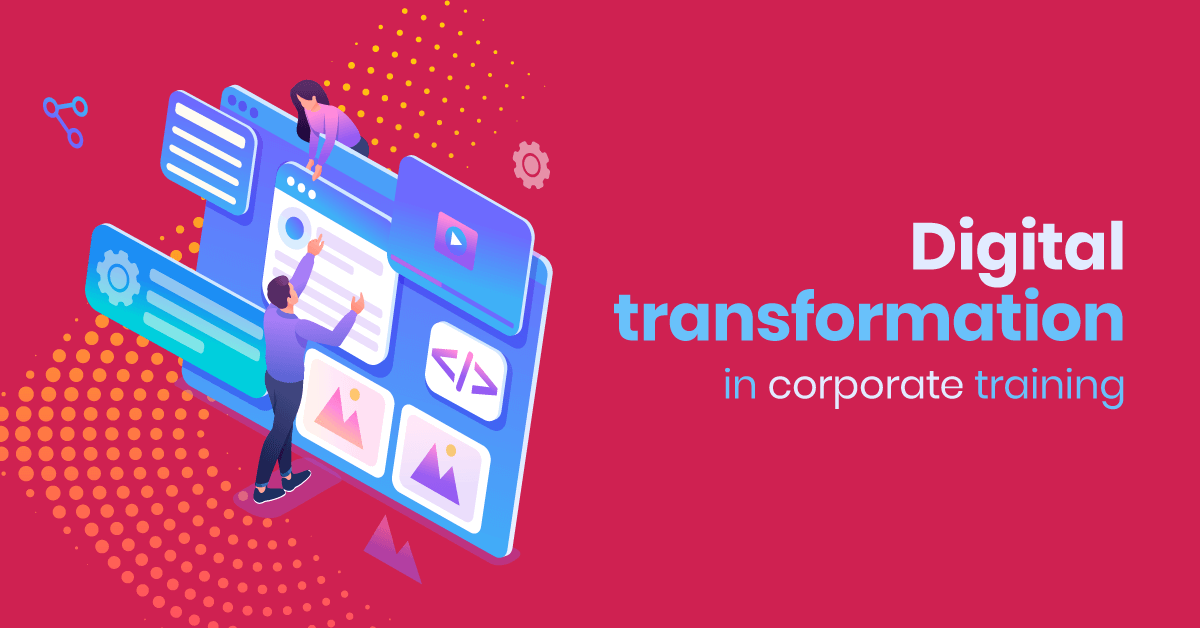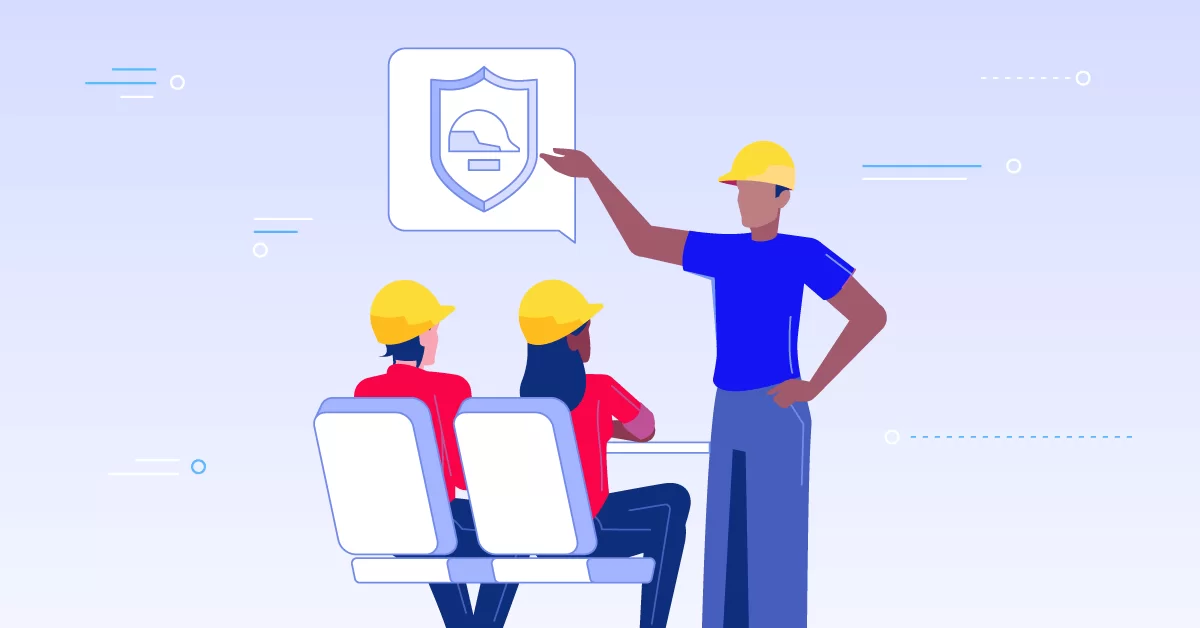But since the pandemic outbreak, it seems like someone pressed the fast-forward button. The expansion and normalization of a remote workforce, coupled with the subsequent increase in connectivity and mobile device use, brought the future of work a bit early.
Which means that in order to maintain your edge against your competitors, you have to adapt quickly. You have to find solutions to problems your company didn’t have before — or doesn’t even have yet. And you need to understand how the different aspects of your company’s digital transformation fit together; where the gaps are. More often than not, you’ll find that these gaps are in your training program.
In this article, we’ll explore the relationship between digital transformation and corporate training. We’ll see how new technologies impact your training strategy — and how, in return, training could help drive digital transformation forward for your company.
What do we mean by digital transformation?
As the phrase itself implies, digital transformation begins with embracing new technologies. These technologies are mostly cloud-based solutions, especially hybrid cloud solutions like Google and Azure, that help companies store and manage their content and data safely. Collaboration tools and automatization processes are also gaining ground, simplifying the management of remote teams and various everyday tasks, from payments to time tracking.
On a global level, companies’ investments in such technologies will amount to several trillion USD in the next few years, and that number is only poised to grow. But the reward is also worth it. Data shows that successfully embracing digital transformation leads to 1.8 times more earnings and more than double the growth overall.
Yet to reap the lasting effects of a successful digital transformation, you need to invest in more than just technology. Here are some of the main changes that also need to take place:
Changes in the work model
Establishing a digital mindset goes beyond just buying and learning how to use a new tool. To minimize disruption and maximize gains from these new technologies, the implementation must be done strategically. Think short sprints, testing all the while, and monitoring results. That requires the whole company to embrace an agile mindset. People should get comfortable with running sprints and short pilots when first tackling new software or a new automatization process.
It also means you’ll probably need something like a Change or Transformation Manager — which brings us to the HR part below.
Changes in HR
Digital transformation also initiates an HR digital transformation. As this SHRM article points out, data collection and analysis is one of the main fields HR needs to do better in order to fully embrace the change and become digital-first. Through tools that can capture and analyze employee data, the HR of the future can offer valuable insights on business and workforce decisions.
An HR digital transformation also means creating new roles. For example, a Change or Transformation Manager (also called Chief Transformation Officer) will design and overview the process. This person’s role is to ensure that every new software a company takes on, serves a purpose and is aligned to the company’s growth and cultural goals.
A good example of how impactful this process can be is Tetra Pak. In 2019, the Swedish food packaging and processing company and its VP Industry 4.0 and Digitalisation Officer launched the “Factory of the Future.” This initiative consisted of smart solutions that made the production of packaging more efficient through AI and automation. Two years later, Tetra Pak is considered one of the leaders in digital transformation and recently teamed up with Microsoft to further digitize their customer service.
Changes in corporate training
But Tetra Pak’s successful implementation of digital solutions (and its subsequent growth) wouldn’t have been possible without a focus on corporate training. The number of average learning hours per employee has practically doubled since 2015 and the company remains committed to helping employees with continuous learning and development.
Tetra Pak is not the only company to connect the dots between digital transformation and corporate training. Bosch sees digital transformation as a slow journey that requires cultural change — and this change comes from training. Since 2012, Bosch operates an IoT (Internet of Things) lab in Germany that helps train and upskill engineers and machine workers alike on how to use and harness data. According to Mike Mansuetti, President of North America at Bosch, the goal is to not only transform the company but also “each individual’s understanding of where they fit in that journey.”

How digital transformation impacts corporate training
We’ve already seen that for digital transformation to succeed, it needs to touch every aspect of the company — from HR to training. So how does digital transformation in training look like?
Here are several things that are changing:
The interest & investment in training
We’re already seeing an uptick in the companies offering continuous training to their employees. This trend is only going to increase in a post-digital transformation era. Products and processes are changing fast and companies need to ensure their workforce is well-equipped to handle them.
This goes beyond offering training for a specific digital product. It’s about cultivating the skills and culture that will make employees willing and happy to keep adapting and exploring new technologies. Investing in and offering upskilling and reskilling training is going to be a big part of this process.
The types of tech
It goes without saying that digital transformation will affect the technologies used in training — it already has to great extent. Asynchronous communication, for example, has become one of the key aspects of online learning, with learners watching instructional videos and answering questions in their own time.
Immersive technologies like VR and volumetric videos will also become more common for the L&D departments of the future. Volumetric videos are already used for training purposes in certain schools, with the University of British Columbia leveraging them to immerse students in the diagnostic process.
It’s not a big stretch to see the possibilities for corporate training. Creating immersive scenarios with the use of such tech makes it easier to retain information and appeals to different types of learners (visual, auditory, kinesthetic, etc.). It also allows remote learners to “come together” and explore the same VR environment — from the comfort and privacy of their homes.
The training topics
The future of work requires employees that are both digitally savvy and eager learners. A literacy in things like AI, data analytics, cloud computing, and robotic process automation (RPA) will come in handy for most companies.
That being said, soft skills are not becoming obsolete any time soon. If anything, the rise of remote work has shown us that soft skills are critical to maintaining team collaboration and delivering a consistently great customer experience.
The delivery methods
Perhaps the greatest effect digital transformation has had on corporate training has to do with the way training content is being delivered.
From microlearning to gamification and personalization elements, to ensuring content can be viewed on all mobile devices, corporate training has changed a lot. And it will keep changing and evolving as remote training becomes the norm and new technologies become available.
The role of learning in digital transformation
Companies like Tetra Pak and Bosch have clearly shown that it’s possible for L&D to not only go hand-in-hand with digital transformation but lead it as well.
If you’re wondering how your own L&D department can help drive this process for your company, consider the below use cases:
Pilot testing new technologies
Not every new software you’re thinking of investing in will be a good fit for your company’s needs. But since most SaaS and IoT companies offer free (or discounted) trial periods, your L&D team can benefit and do a pilot test run.
You can even incorporate these new tools and technologies into your training program and get quick feedback from learners. This way, you’ll have more data to help you decide whether you should invest in them in the long run.
Creating a culture of digital literacy — in leadership and beyond
It’s not just employees who need to embrace new technologies. A digital transformation in training means that a company’s leadership can (and should) also benefit from it. Hiring a Chief Transformation Officer is a great step in the right direction. But if the CEO and/or the C-suite are not digitally literate, making good decisions when it comes to acquiring new tech will be a challenge.
Your L&D department can help with that.
Traditionally, leadership training took place at some conference hall once a year — but that was both inefficient and disruptive. Online leadership training, with the use of an LMS, gives flexibility to learners and increases engagement. It also significantly decreases the costs, so that even more people in your company can take it. Which, in turn, ensures that more future leaders will be digitally literate.
Promoting agility
Agility, agility, agility. The word is thrown around a lot in articles that discuss the future of work — and for good reason. As you work to digitally transform your company, things will not always go according to plan. Or, plans will change.
Your employees need to be able to make in-the-moment decisions in situations that won’t necessarily be familiar to them. They will need to be willing to test and make mistakes — and that’s where the agile mindset comes in.
Your L&D department is in the unique position to create a corporate training program that will focus on teaching agility (and the soft skills that support it). This will make your company’s digital transformation go much smoother.
Entering the digital transformation era
No longer “something to think about” for the future, digital transformation has become a necessity — if you want your business to survive and grow.
Digital transformation is an all-encompassing process that corporate training, and particularly eLearning, plays a dual part in. You can train people for changes in technology, but you can also change how people gain new knowledge, setting them up for success in the future.



